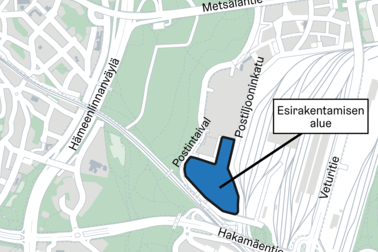Names look to the past – and the future
Designing a new name usually starts with a need: something new is coming, and it needs a name. The Naming Committee convenes about once a month to decide on names, and the decisions it makes are later approved by the City Council as part of the local detailed plans.
"A name's journey from an idea to a road sign can take years," says planning officer Hanna Ikonen, who has worked extensively on naming.
– It comes as a surprise to many that names are created as part of the local detailed plan and its schedule. It can take a very long time from the moment a name is designed to when it is actually introduced into use.
The Naming Committee meetings are a colourful forum for discussion and brainstorming. A name bank can be used as a tool, where previous ideas and name suggestions from residents are stored.
When deciding on new names, several factors need to be taken into account. For example, the mental images that a name might evoke must be considered. According to Suvi Tyynilä, a good name is a combination of a few things.
– A name must be highly useful, for example as an address, but also fit the history and events of a given area.
When designing the future city, the planners always look to the past and to history, according to Johanna Lehtonen.
– First, we do a bit of research to see if there is anything in the environment that could serve as a continuation of the existing themes. However, that is often not possible, so we have to come up with something completely new. For example, old maps are a very good source for learning of things that used to be in the area.
The bilingual nature of Helsinki must also be taken into account. A name must work equally well in Finnish and Swedish. According to Suvi Tyynilä, this is key to designing names.
– As names are created in Finnish and Swedish at the same time, they must both work equally well. There have been many times when a really good street name has been suggested, but no equally good translation has been found.
So, a name that works in one language may end up being discarded if there is no equivalent in the other. The planners must also stay mindful of the overall whole created by all the names. The nearby municipalities are checked to avoid using the same names. Hanna Ikonen says that managing the whole also poses some challenges.
– We have more than 7,000 names in use, and naturally we cannot give the same name twice. In addition, for the sake of clarity, the name themes of certain areas cannot be repeated in other places.
New names are conceived by coming up with word families that follow various themes and help identify different areas of the city. For example, vocabulary related to children's fairy tales is used in Roihuvuori, and if you know this, you might be able to guess where in Helsinki you might find, say, Lumikintie ("Snow White Road"). Consideration is also given to the ease of understanding the name and hence its usability. According to Tyynilä, Lehtonen and Ikonen, coming up with names and deciding on them is a team effort.




